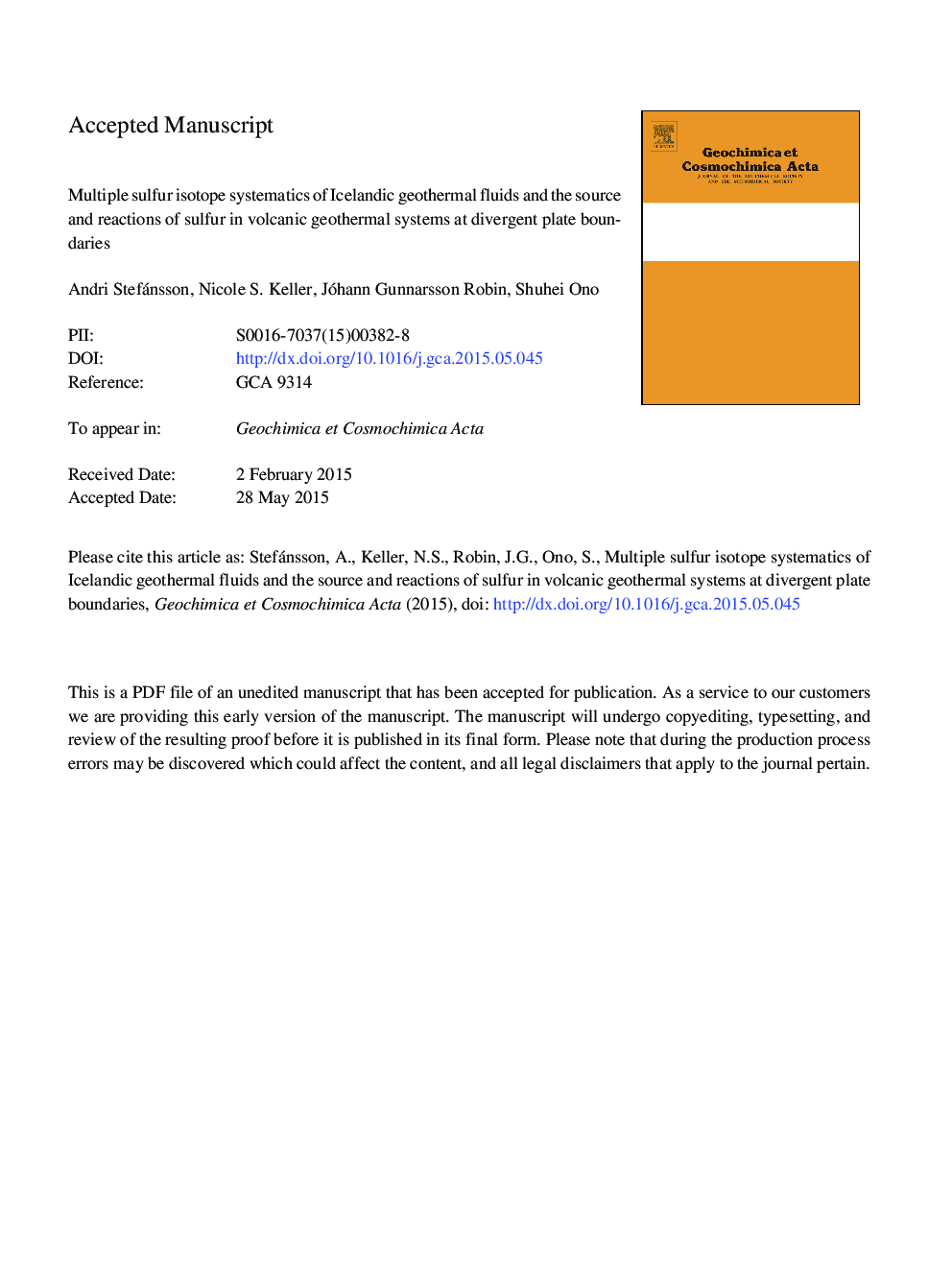| کد مقاله | کد نشریه | سال انتشار | مقاله انگلیسی | نسخه تمام متن |
|---|---|---|---|---|
| 6437890 | 1637992 | 2015 | 54 صفحه PDF | دانلود رایگان |
عنوان انگلیسی مقاله ISI
Multiple sulfur isotope systematics of Icelandic geothermal fluids and the source and reactions of sulfur in volcanic geothermal systems at divergent plate boundaries
ترجمه فارسی عنوان
سیستماتیک ایزوتوپهای گوگرد چندگانه مایعات جیترمال ایسلند و منبع و واکنش گوگرد در سیستم های زمین گرمایی آتشفشان در مرزهای صفحات واگرا
دانلود مقاله + سفارش ترجمه
دانلود مقاله ISI انگلیسی
رایگان برای ایرانیان
موضوعات مرتبط
مهندسی و علوم پایه
علوم زمین و سیارات
ژئوشیمی و پترولوژی
چکیده انگلیسی
Multiple sulfur isotope systematics of geothermal fluids at Krafla, Northeast Iceland, were studied in order to determine the source and reactions of sulfur in this system, as an example of a geothermal system hosted on a divergent plate boundary. Fluid temperatures ranged from 192 to 437 °C, and the fluids have low Cl concentration between â¼10 and â¼150 ppm, with liquid water and vapor being present in the reservoir. Dissolved sulfide (S-II) and sulfate (SVI) predominated in the water phase with trace concentrations of thiosulfate (S2O32-) whereas sulfide (S-II) was the only species observed in the vapor phase. The reconstructed sulfur isotope ratios of the reservoir fluids based on samples collected at surface from two-phase and vapor only well discharges indicated that δ34S and Î33S of sulfide in the reservoir fluid ranged from â1.5 to +1.1â° and â0.001 to â0.017â°, respectively, whereas δ34S and Î33S of sulfate were significantly different and ranged from +3.4 to +13.4â° and 0.000 to â0.036â°, respectively. Depressurization boiling upon fluid ascent coupled with progressive fluid-rock interaction and sulfide mineral (pyrite) formation results in the liquid phase becoming progressively isotopically lighter with respect to both δ34S and Î33S. In contrast, H2S in the vapor phase and pyrite become isotopically heavier. The observed Î33S and δ34S systematics for geothermal fluids at Krafla suggest that the source of sulfide in the reservoir fluids is the basaltic magma, either through degassing or upon dissolution of unaltered basalts. At high temperatures, insignificant SO4 was observed in the fluids but below â¼230 °C significant concentrations of SO4 were observed, the source inferred to be H2S oxidation. The two key factors controlling the multiple sulfur isotope systematics of geothermal fluids are: (1) the isotopic composition of the source material and (2) the isotope fractionation associated with aqueous and vapor speciation and how these change as a function of processes occurring in the system, including boiling, oxidation and fluid-rock interaction.
ناشر
Database: Elsevier - ScienceDirect (ساینس دایرکت)
Journal: Geochimica et Cosmochimica Acta - Volume 165, 15 September 2015, Pages 307-323
Journal: Geochimica et Cosmochimica Acta - Volume 165, 15 September 2015, Pages 307-323
نویسندگان
Andri Stefánsson, Nicole S. Keller, Jóhann Gunnarsson Robin, Shuhei Ono,
